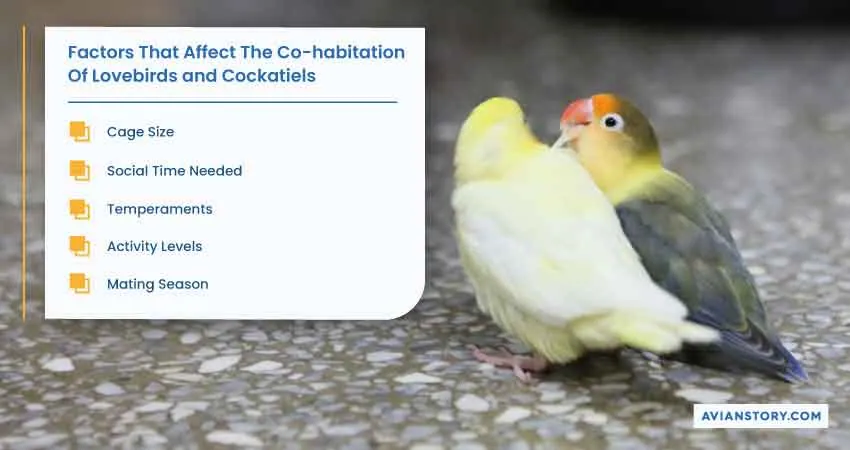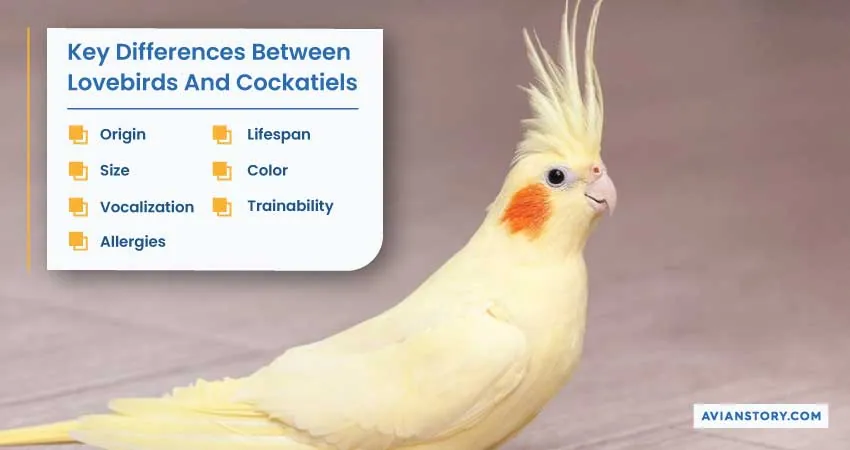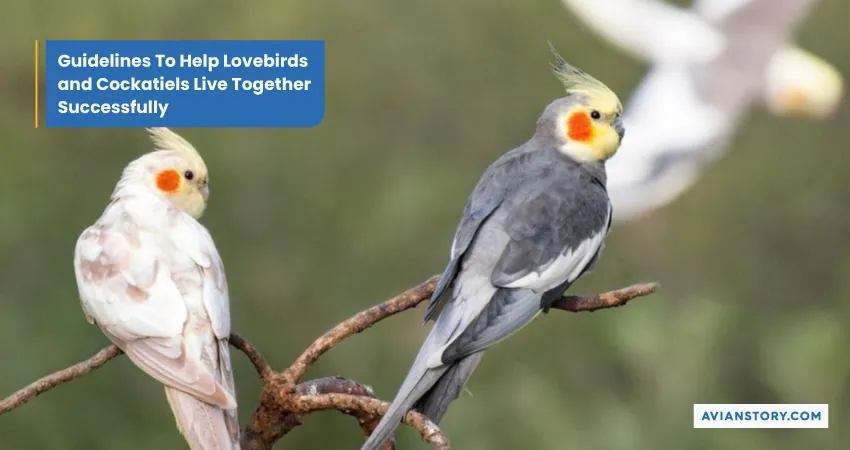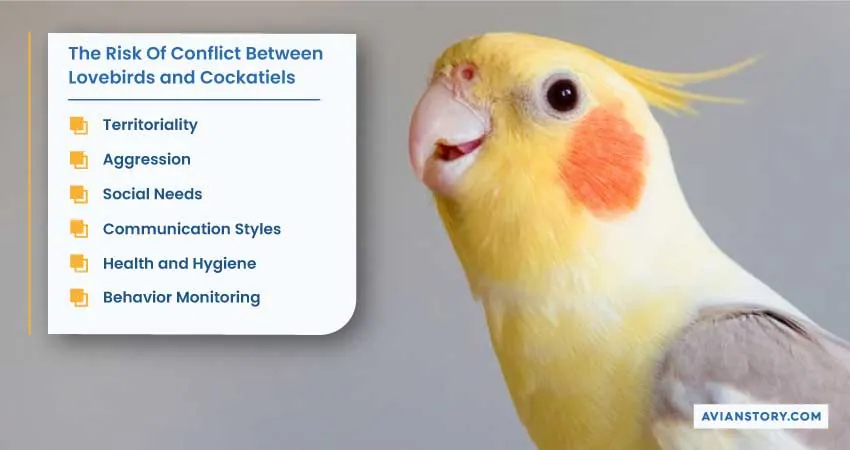Can Lovebirds and Cockatiels Live Together in the Same Cage?
When it comes to keeping multiple bird species as pets, one common question that arises is whether lovebirds and cockatiels can live together harmoniously.
Can lovebirds and cockatiels live together? The answer is a clear no. Lovebirds and cockatiels require
- Different cage sizes
- Have varying social requirements
- Exhibit contrasting temperaments
- Show discrepancies in activity levels and mating season behaviors
Continue reading to explore key differences between these avian species, provide tips for successful cohabitation if you choose to proceed, and discuss strategies to minimize the risk of conflicts.
Can Lovebirds and Cockatiels Live Together?
In short, the answer is no. Lovebirds and cockatiels have different needs and behaviors that make it challenging for them to live together peacefully. It’s crucial to prioritize their individual requirements to remain healthy and happy.
Cohabitation between these species often leads to stress, aggression, and potential harm to one another. Therefore, keeping them in separate enclosures is best to prevent any negative outcomes.
Factors That Affect The Co-habitation Of Lovebirds and Cockatiels

Several factors play a significant role in determining whether lovebirds and cockatiels can cohabitate successfully. Let’s explore each factor in detail:
Cage Size
Lovebirds require a spacious cage measuring at least 36 inches in length, 24 inches in width, and 36 inches in height. They need ample room to explore and fly around, along with multiple perches for exercise and play.
On the other hand, cockatiels prefer a taller cage, measuring around 24 inches in length, 18 inches in width, and 24 inches in height. This ideal cage size for cockatiels allows them to comfortably climb and explore their surroundings.
It is important to strike a balance. Cockatiel cage setups should not be too overwhelming for them. You should also provide toys for a cockatiel for your bird to play with.
Social Time Needed
Lovebirds crave constant attention and human interaction. They are highly social birds that require significant time and engagement from their owners.
On the contrary, cockatiels are relatively independent and require less human interaction to thrive. Their need for social time differs greatly, creating imbalances and potential conflicts when housed together.
Temperaments
Lovebirds are known for their aggressive and territorial behavior, often displaying biting tendencies. They can defend their space quickly and be hostile toward other birds.
In contrast, cockatiels are generally more docile and less prone to aggression. These temperament differences can lead to clashes and stress if they are forced to coexist in the same environment.
Activity Levels
Lovebirds are highly active birds, constantly in motion throughout the day. While they require less out-of-cage time, they need plenty of physical activity within their enclosure.
Conversely, cockatiels are less active than lovebirds but require more out-of-cage time for mental and physical stimulation. This difference in activity levels can create challenges when attempting to house them together.
Mating Season Behaviors
During mating season, lovebirds can become jealous, and hormonal, and exhibit territorial behaviors. They may display aggression towards other birds, including cockatiels.
This heightened aggression can result in serious injuries and even fatalities if housed together during this sensitive period. It is crucial to separate them and provide individual care during mating season.
Key Differences Between Lovebirds And Cockatiels

To gain a deeper understanding of why lovebirds and cockatiels are incompatible, here is a table showing key differences between these avian species:
| Difference | Lovebirds | Cockatiels |
| Size | 6-7 inches | 10-12 inches |
| Weight | 1-2 ounces | 2-4 ounces |
| Noise | Continuously squeaky | Less noise |
| Lifespan | 15-25 years | Up to 20 years |
| Color | Vibrant and diverse | Generally gray with hints of white and yellow |
| Trainability | More challenging to train | More trainable, can mimic sounds and learn tricks |
| Allergies | No allergies | Potential for allergies |
Here is an in-depth dive into all these differences.
Size
Lovebirds are relatively smaller, measuring around 6 to 7 inches in length, while cockatiels are larger, ranging from 10 to 12 inches.
Lovebirds weigh around 1 to 2 ounces, while cockatiels weigh approximately 2 to 4 ounces. The size and weight disparity between the two species can create an imbalance of power, leading to potential conflicts.
Noise
Lovebirds are known for their continuous squeaky vocalizations. They tend to be louder and more vocal than cockatiels, which generally produce less noise. This difference in noise level can be a source of irritation for both you and the birds.
Lifespan
Lovebirds have an average lifespan of 15 to 25 years, while cockatiels can live up to 20 years. The difference in their lifespan can pose challenges regarding long-term commitments and compatibility. It’s essential to consider the potential longevity of these birds before considering their cohabitation.
Color
Lovebirds exhibit vibrant and diverse color variations, with shades of green, red, blue, and yellow present in different species.
In contrast, cockatiels are generally gray with hints of white and yellow. The difference in coloration adds to the aesthetic appeal of having these birds as pets but does not significantly impact their compatibility.
Trainability
Cockatiels tend to be more trainable compared to lovebirds. They are known for mimicking sounds and even learning simple tricks.
Lovebirds, while intelligent, may be more challenging to train due to their independent nature and aggressive tendencies. Their varying trainability can affect the overall experience of keeping them together.
Allergies
Some individuals may have allergies to specific bird species. When planning to house lovebirds and cockatiels together, it is important to consider potential allergic reactions.
Cockatiels are quite dusty and are prone to causing allergies if you are near them. However, lovebirds are not dusty. So they do not cause allergies for their owners.
Guidelines To Help Lovebirds and Cockatiels Live Together Successfully

While cohabitation between lovebirds and cockatiels is generally discouraged, if you are determined to give it a try, there are some guidelines to follow:
1. Everyone in their own cage: Provide separate enclosures for each bird to ensure their individual space and well-being.
2. Introduce them gradually: If you want to allow them supervised socialization time, introduce them gradually in a neutral space under close supervision. Be prepared to separate them at the first sign of aggression.
3. Take precautions during breeding seasons: During lovebirds’ mating season, it is crucial to separate them from other birds, including cockatiels, to prevent aggression and potential harm.
4. Choose a large outdoor cage: If you have sufficient space, consider creating a large outdoor aviary that allows both species to have their own designated areas. This setup reduces the risk of conflicts and promotes a more natural environment for the birds.
How To Minimize The Risk Of Conflict Between Lovebirds and Cockatiels?

To minimize the risk of conflict between lovebirds and cockatiels, consider implementing the following measures:
1. Put obstacles on the free-flight area: Introduce barriers, perches, and visual dividers within the shared space to create distinct territories for each bird. This helps prevent direct confrontations and territorial disputes.
2. Provide a sufficient number of perches, bowls, and water points: Ensuring adequate resources reduces competition and minimizes potential conflicts between the birds.
3. Eliminate all objects that can be used for nesting: Remove objects that could trigger hormonal behavior and nesting instincts, as this can exacerbate aggression and territoriality.
4. Install primary screens to create separate spaces inside the cage: Utilize cage dividers or screens to create distinct zones within the enclosure, giving each bird its own safe space and reducing the chances of aggression.
FAQs
Here are a few more related questions that you might be interested in.
Do cockatiels need another bird?
While cockatiels can live alone and bond with their human caretakers, they are highly social birds that thrive on the companionship of their own species. Consider getting a companion cockatiel to fulfill their social needs.
What birds can be kept with cockatiels?
Cockatiels can be kept with other compatible bird species, such as parakeets, budgies, and certain parrots. However, it is important to introduce new birds gradually and monitor their interactions to ensure compatibility and prevent aggression.
Can lovebirds survive alone?
Lovebirds are highly social birds and thrive in the company of other lovebirds. Nevertheless, they can survive alone with proper care and attention from their human caretakers. However, their overall well-being and happiness are best achieved when they have a companion of their own species.
Conclusion
честные казино с быстрыми выплатами
бездепозитные бонусы казино
играть в лучшем казино на деньги
база казино с бездепозитным бонусом
онлайн казино России
casino oyunu
In conclusion, can lovebirds and cockatiels live together? The answer is a resounding no. Lovebirds and cockatiels have distinct needs, behaviors, and temperaments that make cohabitation challenging and potentially harmful to their well-being.
While it may be tempting to house lovebirds and cockatiels together, it is crucial to prioritize these birds’ individual needs and safety. Provide them with their own suitable environments and ensure their specific requirements are met. You can ensure that both lovebirds and cockatiels live healthy, happy lives as separate companions.
